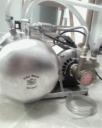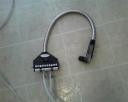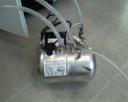Soda fountain project, part I (...or Tabletop Fizz'in)
Ok, well, I have a project. It all started when, thanks to a fortunate encounter with the owners of a bar that was going out of business, I obtained one of those bar soda-guns (actually four of them) and an assortment of some (but not all) of the parts needed to make it work. My initial thought was to clean the stuff up and eBay it, which I will probably do with the spares, but I figured, why not try putting together at least one system, and have my own soda fountain? After all, having a faucet in your house that dispenses cold, running soda-pop is something just about everyone has dreamed of as a kid, and what's the use of being an adult if ya don't actually get one of those dreams ever now and then? :)
Ok, so, let's start with how these things work: The soda-guns used in bars are mostly post-mix devices, that mean that they mix a concentrated soda syrup with carbonated water right in the nozzle of the gun when you press the button. Usually it's mixed 5 parts soda-water to 1 part syrup. Here's the soda-gun I'm going to use:
The gun itself is a passive device, it's basically just a faucet. This one has six buttons on it for soda, pushing one just opens the valve for the soda-water and one of the valves for the syrup. (there's also a button that just does soda-water) This gun actually has two water inputs, so if you want, you can dispense both soda and from-concentrate non-carbonated drinks like orange juice. I have both inputs hooked up for soda-water, tho. If you look closely, you can see the white valves on the base of the gun's hose. Those are used to set the flow rate for the syrup, relative to the soda-water, so you can get the right ratio (a process called 'brixing').
Next up, we have the actual source of the soda-water, the carbonator :
Here's the basics of carbonating water: CO2 will dissolve in water fairly easily. How much CO2 dissolves depends on two things, the temperature and the pressure. The colder the water, the more CO2 will dissolve in it. Also, the higher the pressure, the more CO2 will dissolve in the water. This carbonator uses high pressure to dissolve alot of CO2 in the water. If you take a look at the photo to the left, you will see a thinner hose going off to the right. That is hooked up to a CO2 tank and regulator like so:
This supplies CO2 gas at about 100psi to the carbonator, this supplies the pressure to carbonate the water (it helps to chill the water too, but we'll get to that in a minute). The main part of the carbonator is that barrel-shaped silver tank. Water is pumped in by the pump on the side, which you can see better in this side-view below:
 bigger side view of carbonator
bigger side view of carbonator
(The pump is the brass part on the side. It's driven by the black electric motor) The water has to be pumped in because the carbonator tank is pressurized to 100psi by the CO2 gas. The pump will fill the tank about half-way then shut off. (it's controlled by a float switch in the carbonator tank, the round black object on the top of the tank is the top of the float switch) The water is exposed to the high-pressure CO2 in the tank, absorbing some of it. When the soda-water valve is opened in the soda gun, pressure drives the soda-water out the outlets (the two hoses on the top of the carbonator tank) to the soda gun. Periodically, the pump will kick on to refill the tank. That's basically it.
Now, in my case, the carbonator and gas related parts like the CO2 tank and regulator were the parts I was missing, so I had to buy those. I picked the carbonator up on eBay for $150 It's a McCann's E200097. The seller said it was a refurb, but it looks like brand new. I picked up the CO2 regulator here. Note that the regulator has to supply 100psi! There are a lot of regulators, used for pressurizing beer kegs, that won't go much over 50psi, that's not enough to run a carbonator off of. The CO2 tank I picked up at a local welding shop for $90, filled. It's a standard-size 20lb tank and should last for years.
To connect it all together, I used braided-vinyl hose, which any hardware store will have, 1/4" for the gas, 3/8" for the water. Note: VERY IMPORTANT! Use braided vinyl tubing. It has extra reinforcement and will stand up to ~200psi. Both the gas hose, and the soda-water outlet hoses will be exposed to high pressures up to 100psi. Unreinforced vinyl tubing WILL burst at those pressures. Use braided hose, and good hose-clamps. And don't use copper tubing. soda-water is corrosive, and can leach toxic amounts of copper from the tubing.
When hooking things up, a good trick to know is that the vinyl tubing will become much more flexible and rubbery if heated in boiling water. I needed to use that trick since the hose barb on the regulator was 5/16" and the hose was 1/4", after a minute of dipping the end of the hose in boiling water, it went on just fine.
So, this gets us flowing soda-water from the gun. In part II, we'll chill out...


